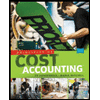
1.
Concept introduction:
Balanced scorecard: A balanced scorecard is a tool of strategic planning which transforms the vision and goals of an organization into a set of performance benchmarks that are applied to assess the performance, and thus determine if goals are being fulfilled or not. The balanced scorecard involves assessing four main aspects of the organization which are learning and growth, internal processes, customers, and finance.
A balanced scorecard for H Department Store.
2.
Concept introduction:
Balanced scorecard: A balanced scorecard is a tool of strategic planning which transforms the vision and goals of an organization into a set of performance benchmarks that are applied to assess the performance, and thus determine if goals are being fulfilled or not. The balanced scorecard involves assessing four main aspects of the organization which are learning and growth, internal processes, customers, and finance.
To explain: Certain measures of performance show improvement while others do not and suggest the steps that management can take in such circumstances.
3.
a.
Balanced scorecard: A balanced scorecard is a tool of strategic planning which transforms the vision and goals of an organization into a set of performance benchmarks that are applied to assess the performance, and thus determine if goals are being fulfilled or not. The balanced scorecard involves assessing four main aspects of the organization which are learning and growth, internal processes, customers, and finance.
To explain: The improvement in customer satisfaction with regards to the accuracy of their charge account bills does not lead to any improvement in the average age of accounts receivable and bad debt measures.
3.
b.
Balanced scorecard: A balanced scorecard is a tool of strategic planning which transforms the vision and goals of an organization into a set of performance benchmarks that are applied to assess the performance, and thus determine if goals are being fulfilled or not. The balanced scorecard involves assessing four main aspects of the organization which are learning and growth, internal processes, customers and finance.
To explain: The total profits do not increase in spite of improvement in the performance measures relating to bad debts, unsold inventory, and average accounts receivable.
Want to see the full answer?
Check out a sample textbook solution
Chapter 12 Solutions
MANAGERIAL ACCOUNTING-EBOOK ACCESS
- Help pleasearrow_forwardPlease provide problem with accounting questionarrow_forwardJuan Leon Martinez posted Apr 7, 2025 11:25 AM Subscribe Hello everyone, Esteban is not performing in a professional manner in this scene. In fact, he is showing extreme unprofessional manners and unethical work ethic. Under no circumstance should he be using a company's tools or assets for his own benefit. You can also see he is trying not to get caught by any upper management due to him doing these actions after hours of work. As a manager, a great change I would do differently to make sure Esteban is not using the company's assets for their own benefit, would be coachings and sit down conversations. A sit down conversation can have the employee get an idea on how bad his actions are towards the company. This disciplinary of a coaching would be a written down statement from both manager and employee stating that he or she understands the actions they have done, which could lead to suspension or possibly termination. These unethical actions could lead to a great deal of financial loss…arrow_forward
 Financial Reporting, Financial Statement Analysis...FinanceISBN:9781285190907Author:James M. Wahlen, Stephen P. Baginski, Mark BradshawPublisher:Cengage Learning
Financial Reporting, Financial Statement Analysis...FinanceISBN:9781285190907Author:James M. Wahlen, Stephen P. Baginski, Mark BradshawPublisher:Cengage Learning Managerial AccountingAccountingISBN:9781337912020Author:Carl Warren, Ph.d. Cma William B. TaylerPublisher:South-Western College Pub
Managerial AccountingAccountingISBN:9781337912020Author:Carl Warren, Ph.d. Cma William B. TaylerPublisher:South-Western College Pub Cornerstones of Financial AccountingAccountingISBN:9781337690881Author:Jay Rich, Jeff JonesPublisher:Cengage Learning
Cornerstones of Financial AccountingAccountingISBN:9781337690881Author:Jay Rich, Jeff JonesPublisher:Cengage Learning Cornerstones of Cost Management (Cornerstones Ser...AccountingISBN:9781305970663Author:Don R. Hansen, Maryanne M. MowenPublisher:Cengage Learning
Cornerstones of Cost Management (Cornerstones Ser...AccountingISBN:9781305970663Author:Don R. Hansen, Maryanne M. MowenPublisher:Cengage Learning Accounting Information SystemsAccountingISBN:9781337619202Author:Hall, James A.Publisher:Cengage Learning,
Accounting Information SystemsAccountingISBN:9781337619202Author:Hall, James A.Publisher:Cengage Learning, Principles of Cost AccountingAccountingISBN:9781305087408Author:Edward J. Vanderbeck, Maria R. MitchellPublisher:Cengage Learning
Principles of Cost AccountingAccountingISBN:9781305087408Author:Edward J. Vanderbeck, Maria R. MitchellPublisher:Cengage Learning





